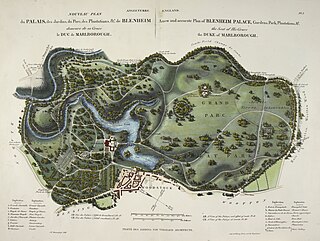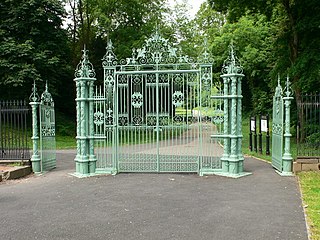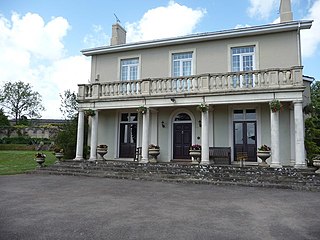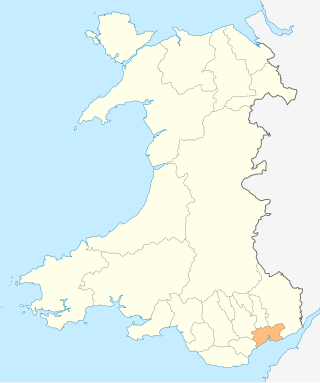Related Research Articles
The Register of Historic Parks and Gardens of Special Historic Interest in England provides a listing and classification system for historic parks and gardens similar to that used for listed buildings. The register is managed by Historic England under the provisions of the National Heritage Act 1983. Over 1,600 sites are listed, ranging from the grounds of large stately homes to small domestic gardens, as well other designed landscapes such as town squares, public parks and cemeteries.

Historic garden conservation is a specialised type of historic preservation and conservation or restoration concerned with historical and landmark gardens and designed landscapes.

Pontypool Park is a 150-acre (0.61 km2) park in Pontypool, Torfaen, Wales. The park was formerly the grounds of Pontypool House and was laid out in the closing years of the 17th century for John Hanbury, an ironmaster, who is closely associated with Japanware. The grounds were purchased by the local authority in 1920, while the estate house was leased, and later sold, to the Sisters of the Holy Ghost to become St. Alban's RC High School. The former stables now house the Torfaen Museum. The grounds contain a number of structures including a double ice house, the Folly Tower and the Shell Grotto. The park is entered through the Pontymoile Gates. The gates, the grotto and the stables are all Grade II* listed structures, while the former hall and the ice house are listed Grade II. The park itself is designated at Grade II* on the Cadw/ICOMOS Register of Parks and Gardens of Special Historic Interest in Wales.

Clytha Park, Clytha, Monmouthshire, is a 19th-century Neoclassical country house, "the finest early nineteenth century Greek Revival house in the county." The wider estate encompasses Monmouthshire's "two outstanding examples of late eighteenth century Gothic", the gates to the park and Clytha Castle. The owners were the Jones family, later Herbert, of Treowen and Llanarth Court. It is a Grade I listed building.

Dewstow House, Caldicot, Monmouthshire, Wales, is an early nineteenth century villa in a Neoclassical style. The house is notable as the site of "one of the strangest gardens in Wales." The building itself is plain; described by architectural writer John Newman as a "simple three-bay villa", it has extensive views over the Severn Estuary. The house is a Grade II listed building, while the garden is listed at the highest grade, Grade I, on the Cadw/ICOMOS Register of Parks and Gardens of Special Historic Interest in Wales.
The Garden History Society was an organisation in the United Kingdom established to study the history of gardening and to protect historic gardens. In 2015 it became The Gardens Trust, having merged with the Association of Gardens Trusts.

Llanerch Hall, Trefnant, Clwyd, Wales, is a country house with medieval origins. It was rebuilt twice at the beginning and at the end of the 17th century, was again rebuilt in the 19th century, and further modified in the 20th. The hall is now divided into flats, each with its own Grade II* listing. The parkland, now a golf course, conceals traces of a late 17th century Italianate terraced garden that rivalled those at Powis Castle. The gardens were entirely destroyed in the 19th century rebuilding. The house remains privately owned.

Rhondda Cynon Taf is a county borough in South Wales. It is located to the north-west of Cardiff and covers an area of 424 km2 (164 sq mi). In 2021 the population was approximately 237,500.

Merthyr Tydfil County Borough is located in the historic county of Glamorgan in Wales and takes its name from its largest town. The county borough covers an area of 111 km2 (43 sq mi) and had a population of approximately 58,900 in 2021. There are three sites on the register of parks and gardens in Merthyr Tydfil County Borough. Two are listed at Grade II*, and one is Grade II.

Monmouthshire is a county and principal area of Wales. It borders Torfaen and Newport to the west; Herefordshire and Gloucestershire to the east; and Powys to the north. The largest town is Abergavenny, with other large settlements being Chepstow, Monmouth, and Usk. The present county was formed under the Local Government (Wales) Act 1994, which came into effect in 1996. It has an area of 850 km2, with a population of 93,200 as of 2021. It comprises some sixty percent of the historic county, known between 1974 and 1996 as Gwent.

The Isle of Anglesey, a principal area off the north-west coast of Wales, includes the islands of Anglesey, Holy Island and some islets and skerries. It covers an area of 711 km2 (275 sq mi) and in 2021 the population was approximately 68,900.

Bridgend County Borough is a county borough in south-east Wales. It covers an area of 251 km2 (97 sq mi). In 2021 the population was approximately 145,800.

Caerphilly County Borough is a county borough in south-east Wales. It covers an area of 227 km2 (88 sq mi). In 2021 the population was approximately 176,000.

The Vale of Glamorgan is a county borough in south-east Wales. It covers an area of 331 km2 (128 sq mi) and in 2021 the population was approximately 132,500.

Neath Port Talbot is a county borough in South Wales. It covers an area of 441 km2 (170 sq mi) and in 2021 the population was approximately 141,900.

The City and County of Swansea is a principal area in south Wales. It covers an area of 380 km2 (150 sq mi) and in 2021 the population was approximately 237,800.

Carmarthenshire is a county in the south-west of Wales. It covers an area of 2,370 km2 (920 sq mi). In 2021 the population was approximately 188,200.

Ceredigion is a county in the west of Wales. It covers an area of 1,785 km2 (689 sq mi) and in 2021 the population was approximately 70,700.

Newport is a city and county borough in the south of Wales. It covers an area of 190 km2 (73 sq mi) and in 2021 the population was approximately 159,700.

Elisabeth Whittle is a garden historian from Wales. A former president of the Welsh Historic Gardens Trust and a trustee of the National Botanic Garden of Wales, her published works include studies of the historic gardens of Wales and of the history of Glamorgan and Gwent. She is a fellow of the Society of Antiquaries of London.
References
- ↑ Laidlaw, Ros (2010). "Historic Parks and Gardens in Wales". Buildingconservation.com. Retrieved 25 March 2023.
- ↑ Reader 2010, p. 10.
- 1 2 "Welsh Historic Gardens Trust (Ymddiriedolaeth Gerddi Hanesyddol Cymru) – Charity 1023293". Charity Commission . Retrieved 15 December 2022.
- ↑ "Welsh Historic Gardens Trust". Building Conservation. Retrieved 15 December 2022.
- ↑ "WHGT branches". Welsh Historic Gardens Trust. Retrieved 15 December 2022.
- ↑ "WHGT newsletter". Parks & Gardens UK. Retrieved 15 December 2022.
- ↑ "About WHGT". Welsh Historic Gardens Trust. Retrieved 15 December 2022.
- ↑ "Elisabeth Whittle". National Botanic Garden of Wales . Retrieved 15 December 2022.
- 1 2 Whittle 1992, p. 6.
- 1 2 "Registered historic parks and gardens". Cadw . Retrieved 15 December 2022.
- ↑ Cadw 2017, p. 4.